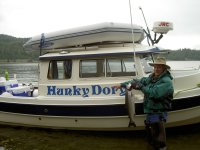We towed a West Marine RU-260 for our entire trip to the Gulf Islands, Princess Louisa Inlet, Desolation Sound, and Howe Sound. We cruised at a wide range of speeds...all the way from 5 knots to 23 knots, and never had a problem. Even in very rough conditions the dinghy towed okay. A few conditions caused us some anxiety, but never any problem. These were when going slowly in a following sea and when going fast in a head sea. Slowly in a following sea resulted in the dinghy sometimes burying its bow. We towed with the plug out, and the water would quickly drain, but you sure noticed the extra resistance when driving. Fast in a head sea, especially with a strong head wind, resulted in the dinghy becoming airborne on a few occasions, but it never flipped. Ultimately, C-Dory's really don't like to go too fast in a steep head sea anyway, so it wasn't too big a deal.
If you do tow make sure you have appropriate gear. Make sure you have a bridle for the dinghy since the adhesive used to attach the hardware on the inflatables is very strong when dealing with lateral forces but will pull off easily from other forces. We used a heavy duty bridle from Boaters World to attach to the boat that was designed for pulling multiple tubes. This attached with a carabiner to about 25 feet of 1/2 inch polypropylene line and then to another carabiner around the bridle on the dinghy. When we were docking, anchoring, or otherwise maneuvering the dinghy was pulled in and secured to the side of the boat.


